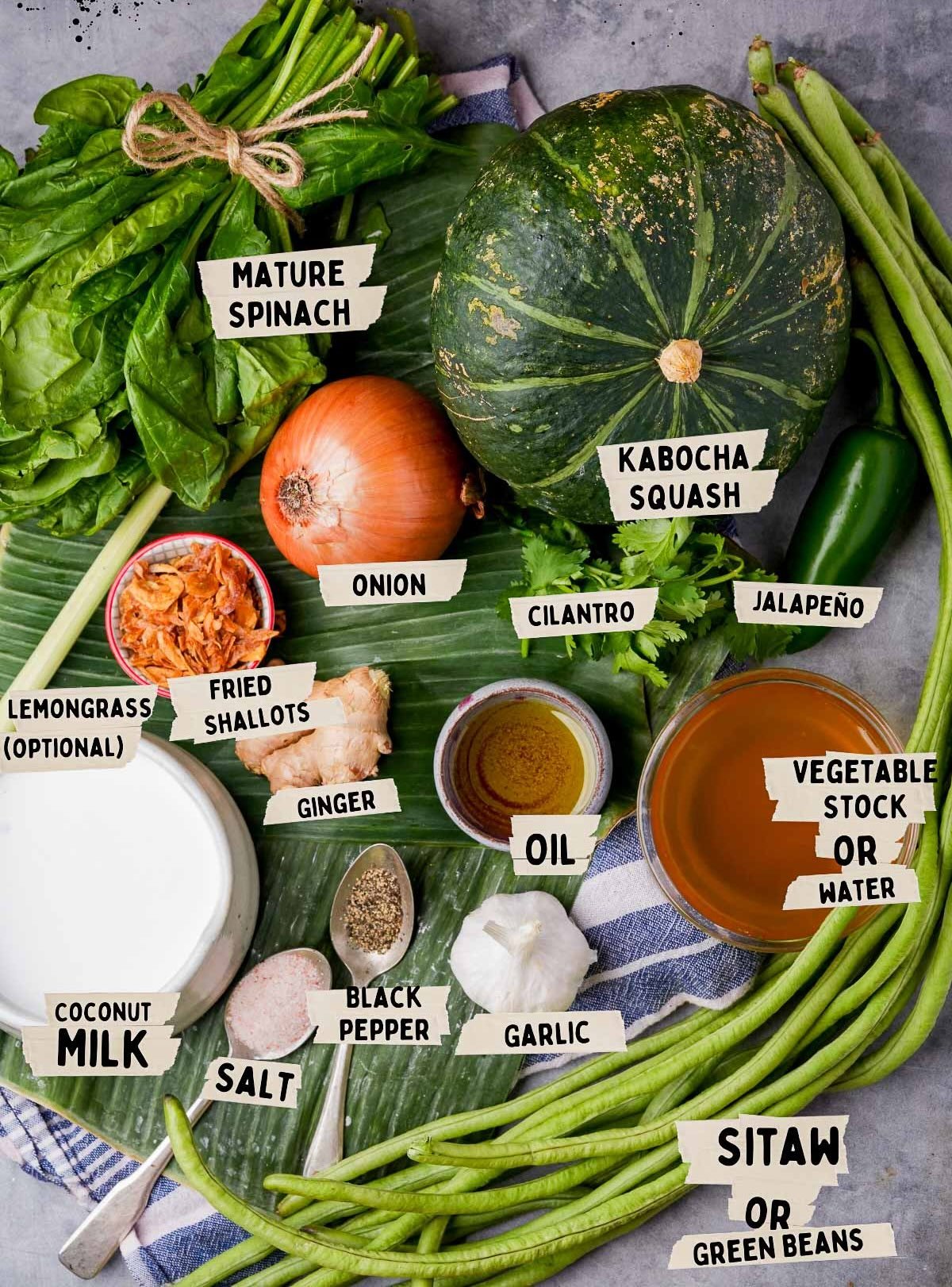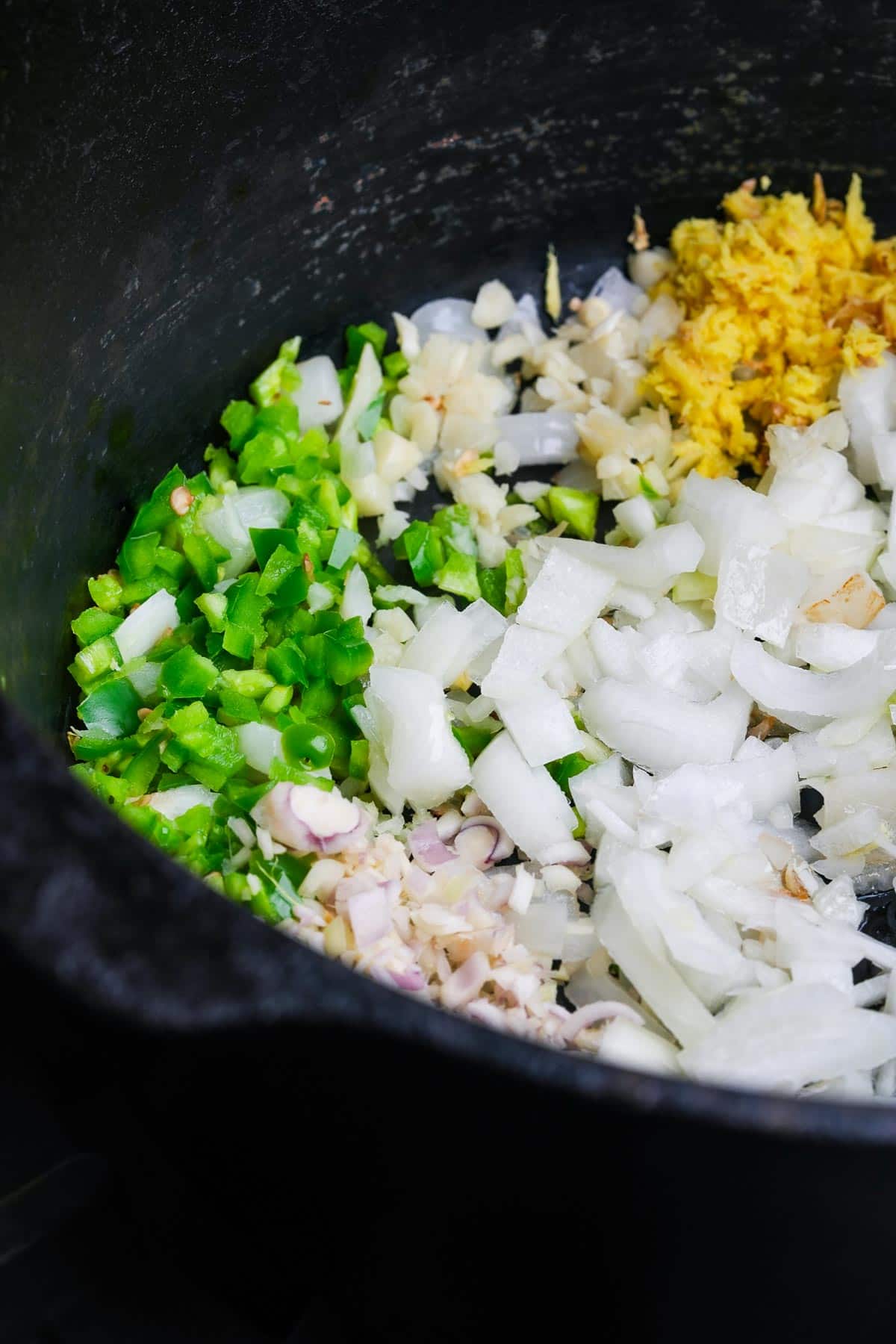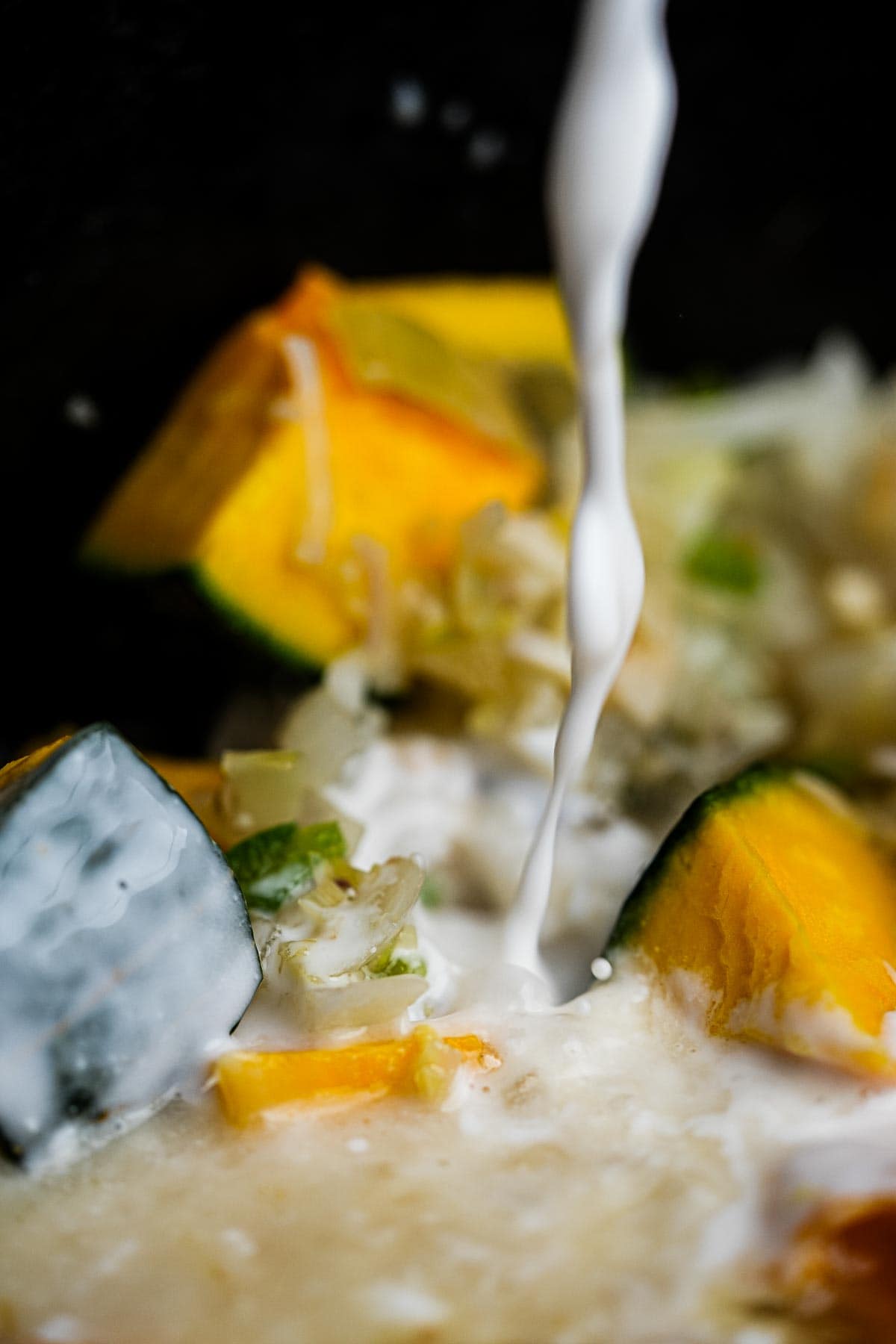*This post may contain affiliate links. Read more »
Ginataang Kalabasa comes with many names: in Cebuano, it’s dinuldog, and kalabasa sa gata in Tagalogor or ginatanng sitaw at kalabasa (alternately ginatanng kalabasa at sitaw) when long beans are used. We’re making ginataang sitaw kalabasa. This classic Filipino stew shows off the country’s rich culinary tapestry with the creaminess of coconut milk and the subtle heat of aromatic spices.
The name simply translates to "Squash in Coconut Milk," but you can think of this as a complete Filipino curry. Goes without saying, if you like Filipino recipes with coconut milk, you’ve gotta this. It’s great on its own or over coconut rice, aromatic pilau, or turmeric rice. Commonly also called Kalabasa sa Gata (gata is another name for coconut milk), this stew is a Bicol favorite, celebrated for its rich mix of coconut milk, veggies and spice.


Enter your email & I'll send it to your inbox. Plus, get great new recipes from me every week!
By submitting this form, you consent to receive emails from Cinnamon Snail.
Commonly also called Kalabasa sa Gata (gata is another name for coconut milk), this stew is a Bicol favorite, celebrated for its rich mix of coconut milk, veggies and spice.
Ginataang means "cooked in coconut milk", which is also why ginataang lanka (jackfruit in coconut milk with chilies) got its name.
If you're vegetarian or vegan, you will be psyched about Ginataang Kalabasa at Sitaw, called that because it has sitaw (long beans in it). While mainstream Filipinos are big on meat and seafood, there is a large and growing vegan community, especially in cities like Manilla who crave vegan Filipino dishes. I was blown away when I cooked there at the World Street Food Congress that a bunch of people who came not only knew of Cinnamon Snail, but many even brought copies of my cookbook to sign!
Best of all, this delicious Filipino recipe for squash is well-tested, and takes no time to make if you are in a rush to get a nourishing meal on the table! Let's get cooking!
Jump to:
- 🥰Why you'll adore this recipe
- 🌱 Ingredients for ginataang kalabasa with spinach
- 🤯 A couple other ginataang recipes:
- 📖 How to make Ginataang Kalabasa Sitaw
- 💡Serving Ideas for this ginataang kalabasa with spinach
- 👉Tips to nail this recipe
- 🤷♀️FAQ
- ✌️ Vegan Filipino recipes to pair with this:
- Ginataang Kalabasa (Vegan Filipino Coconut Milk Stew)
🥰Why you'll adore this recipe
✊ Vegan AF and GF: While many ginataang kalabasa recipes include pork belly or shrimp, you will not find ANY of that in this Ginataang Kalabasa Sitaw recipe! Like all of my Filipino recipes, it is 100% plant-based, and this recipe just happens to be gluten-free too!
🥥 Coconut Milk Magic: The secret to the velvety richness of this stew lies in the full-fat coconut milk, which helps carry the flavors of the veggies and spices, coating your mouth in their heavenly flavors.
🍲 Foolproof Kabocha Squash: Squash can be a pain in the butt to peel! There is no need to struggle with peeling in this squash recipe (Pinoy) as the kabocha squash skin adds an extra layer of flavor and nourishment, making your prep work a breeze.
✅ Tested and Approved Worldwide: Just like all recipes on my blog, this Ginataang Kalabasa recipe has been meticulously tested and re-tested by me, and then shared with a global team of recipe testers. Rest assured that this Pinoy veggie recipe works like a charm, no matter where on the planet you are!


🤫 Learn the secrets for perfect vegan Filipino meals
This guide to my most popular plant-based recipes from the Philippines is 100% FREE, & you'll love the actual heck out of it 🥰
🌱 Ingredients for ginataang kalabasa with spinach

Kabocha Squash
Kabocha squash is the Kalabasa in Ginataang Kalabasa. Its vibrant orange flesh is a feast for the eyes and a nutritional powerhouse packed with fiber, vitamins A and C, and antioxidants. You can also make this with pumpkin, acorn squash or butternut squash if you can’t get kabocha, but all those substitutes WILL need to be peeled.
Coconut Milk
Made from the processed flesh of mature coconuts, coconut milk infuses this stew with a rich, tropical essence. You’ll find many Filipino recipes using coconut milk, because, beyond its luxurious taste, it brings a dose of healthy fats and a creamy consistency that defines Ginataang Kalabasa. Don't use coconut cream, which is better suited to recipes like Vietnamese Kem Chuoi.
Sitaw (Long Beans)
In the Philippines, these vibrant green beans are called “Sitaw." They are the same Filipino veggie I use in my Adobong Sitaw, Lotong Sayur Lodeh, and Sambal Goreng recipes. If sitaw is hard to get, green beans (like you would use to make urap sayur), string beans, or runner beans (like I use to make Zeytinyağlı Taze Fasulye Tarifi) will be fine substitutes in this king of vegetarian Filipino recipes.
Spinach
Bunched mature spinach leaves bring a nutrient-rich boost to this vegan Filipino dish. They are the same kind I use to make saag aloo. Don’t use baby spinach in this recipe as it sorta gets slimy when it cooks. So if you can’t get mature bunched spinach, opt for a different green entirely, like collard greens or Swiss chard.
Onion (Sibuyas)
Sautéed to golden perfection, diced onions add a sweet, aromatic undertone to the stew's savory flavors. If you are an onion freak, you could serve some onion bhaji along with this stew to be on onion cloud-9! Shallots (which make great sambal dabu dabu and sambal matah) offer a good alternative, though, in my opinion, they are even more likely to make you cry than regular onions when you handle ‘em.
*See the Ginataang (Filipino recipe) card at the bottom of the page for exact quantities, nutritional info, and detailed cooking directions.
🤯 A couple other ginataang recipes:
🇵🇭 A Bicol Filipino Dish with Coconut Milk that Slaps Hard:
For a fiery vibe from the Bicol region of the Philippines, add plenty of very finely chopped bird's eye chilies and a generous helping of finely minced lemongrass (or lemongrass powder) during the sautéing stage. The result? A Ginataang Kalabasa with a spicy kick and a great-smelling citrusy undertone.
🏝️ Meaty Vegan Ginataang Galabasa:
Since many people put pork and poor little defenseless fishies in their Ginataang Kalabasa you can replicate some of those flavors and textures by adding a little seitan, vegan sausage, or jackfruit (what I use in my kathal ki sabji), and a splash of vegan fish sauce or nuoc cham. This may imitate the pork with squash Filipino recipes without harming any poor beastie.
📖 How to make Ginataang Kalabasa Sitaw
Nail this stew on your first shot by following these step-by-step instructions with important tips. Or you can follow along with the easy-to-print recipe card towards the bottom of this page.

Step One
Start the flavors off strong:
Warm oil in a sturdy pot or Dutch oven over medium heat. After 90 seconds, when the oil is sizzling, introduce diced onions, minced garlic, jalapeño, grated ginger, and lemongrass if you are using it. Sauté for roughly 5 minutes until the aroma dances in the air.

Step Two
Lock in the flave’:
Add diced kalabasa (kabocha squash) to the pot and give it a gentle stir. Pour in the unsalted vegetable stock or water, then add the coconut milk, salt, and black pepper. Allow this aromatic symphony to simmer until the kalabasa becomes fork-tender, taking around 20-24 minutes.

Step Three
Add the Green Good Stuff:
Once the squash reaches the desired tenderness, stir in the chopped sitaw (or green beans) and the cleaned, chopped mature spinach leaves. Stir until the spinach gracefully wilts, and the green beans achieve that perfect tender-crisp balance.

Step Four
Serve with Mad Style:
Ladle the flavor-packed stew into bowls, garnishing with fried shallots and cilantro leaves. If you want a little extra heat, you can drizzle in a little nam prik pao, or homemade sriracha.
💡Serving Ideas for this ginataang kalabasa with spinach
Ginataang Kalabasa is some good eating in the bathtub if you have had a rough day. I don’t know what it is, but Filipino recipes with coconut milk, stews like this, or noodle dishes like khao suey, bami goreng, bihun goreng, or mee rebus just make all of life’s hard times and icky feelings disappear for me, especially when eaten in a nice hot bath. I know, I'm a little weird. Whatever.
A bun on the side of the bathtub, like in a little waterproof box or something? Why not stuff two banh bao buns in that box!?! Is it a stretch to say that this kalabasa and sitaw recipe is even better in the tub? I mean, to me it is, so there's that.
Of course, Kalabasa pairs perfectly with classic Filipino dishes like laing, tofu sisig, vegan lumpiang Shanghai, or ensaladang talong and Tupig.
Cap off your culinary adventure with delightful desserts like Indonesian Kuih dadar, Putu Ayu, gulaman, martabak manis, or Vietnamese flan. My wife usually has us start with dessert, so like, if you are doing that tub thing I mentioned, maybe smash the dessert before you get in the bathtub…

👉Tips to nail this recipe
- Mindful Kabocha Prep: When dealing with kabocha squash, embrace its nutty skin - no need for peeling. Simply dice it into 2cm pieces, leaving the skin intact for added flavor and texture. This not only simplifies the prep but also enhances the overall richness of the stew. The seeds are trash, though. For real, it’s so sad because there are a ton of them, and normally squash and pumpkin seeds are my fave, but not these. They suck.
- Coconut Milk Consistency: Use full-fat coconut milk to achieve the luscious creaminess that defines Ginataang Kalabasa.
- Balanced Simmering: Achieving fork-tender kalabasa requires patience in simmering. Let the stew bubble away for 20-24 minutes, and add more liquid if the pot starts running dry.
- Green Bean Brilliance: Whether you choose sitaw or green beans, add them at the right moment (towards the end). This way, they will not get all limp and lose their attractive color.
🤷♀️FAQ
While Kalabasa technically means Kabocha squash, you can make most Filipino recipes that call with it by substituting peeled pumpkin, butternut squash or acorn squash.
While you can, the full-fat version contributes to the stew's luxurious creaminess, enhancing the overall taste and texture. If you have to substitute a non-coconut milk, opt for unsweetened oat milk or a thicker, creamier almond milk if you can get your hands on one. This just happens to be one of my fave Filipino recipes using coconut milk because of its luxurious texture.
Reduce or omit the jalapeño. Kids tend to like this dish a little sweeter too, so consider adding a spoonful of coconut sugar or maple syrup to make sure they are happy eating their veggies!
Absolutely, the flavors deepen with a couple of days of the veggies sitting in the flavorful coconut milk broth. Make it ahead and reheat gently, ensuring a delightful, well-developed taste.
🥶Storage:
Store your Ginataang Kalabasa in an airtight container in the refrigerator for up to four days. Don’t freeze it as the veggies' texture will suffer, and the coconut milk may separate and thaw, looking a little thin and oily.
🔥 Stovetop Reheating:
Place your desired portion in a saucepan over medium heat. Add a splash of vegetable stock or water to maintain moisture. Stir occasionally until heated through, ensuring the flavors of this decadent Filipino vegan recipe revive with each gentle simmer.
🔥 Microwave Reheating:
For a quick fix, transfer a serving to a microwave-safe dish. Cover with a microwave-safe lid or damp paper towel to prevent drying. Heat on medium in 1-minute intervals, stirring in between, until the desired warmth is achieved. This ensures a speedy yet equally delectable reawakening of your Ginataang Kalabasa.
✌️ Vegan Filipino recipes to pair with this:

Ginataang Kalabasa (Vegan Filipino Coconut Milk Stew)
Equipment
- Measuring spoons and cups
Ingredients
- 1 tablespoon canola oil
- 1 cup onion small dice
- 4 cloves garlic minced
- 4 teaspoons jalapeño minced (optional)
- 2 teaspoons ginger grated
- ¼ cup lemongrass thinly sliced (optional)
- 2 cups kalabasa kabocha squash, 2 cm. diced (no need to remove the skin, but discard the seeds)
- 4 cups unsalted vegetable stock or water
- 13.5 ounces coconut milk 400 ml., full fat
- 1 ¼ teaspoon salt
- ¼ teaspoon ground black pepper
- 1 ½ cups chopped sitaw or green beans
- 1 lb. mature spinach leaves washed and roughly chopped
To Garnish:
- 4 teaspoons fried shallots
- Fresh cilantro leaves
Instructions
- Heat the oil in a thick-bottomed pot or Dutch oven over medium heat. After 90 seconds, when the oil is hot, add diced onions, minced garlic, jalapeño, grated ginger and optional lemongrass. Sauté for about 5 minutes until fragrant.
- Add diced kalabasa (kabocha squash) to the pot and stir. Pour in the unsalted vegetable stock or water. Add coconut milk, salt, and black pepper. Allow the mixture to simmer over medium heat until the kalabasa is fork-tender, about 20-24 minutes.
- Once the squash is tender, stir in chopped sitaw (or green beans) and the washed and chopped mature spinach leaves. Stir until the spinach wilts and the string beans are just tender.
- Ladle the stew into bowls. Top each serving with fried shallots and fresh cilantro leaves.
Notes

Enter your email & I'll send it to your inbox. Plus, get great new recipes from me every week!
By submitting this form, you consent to receive emails from Cinnamon Snail.











Nomia says
Easy and delicious! Used butternut squash since no kabocha in the grocery (although that is my favorite squash), and topped with some seared tofu for extra protein. Loved it! Will make it again!
Mike Y says
Amazing! Fantastic! The flavors and textures, wow!
Thank you. I’m not vegan.
Adam Sobel says
So glad you loved it Mike! We'll get you vegan yet ❤️
Kate Denner says
Try this recipe!! I subbed butternut squash, Swiss chard and banana peppers for the jalapeño as we grew all of them in our garden. Turned out awesome. Definitely use full fat coconut milk for richness of broth. It was a super one pot meal! PS. Didn’t even have the lemongrass on hand and it was great.